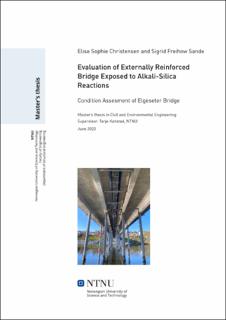| dc.contributor.advisor | Kanstad, Terje | |
| dc.contributor.author | Sande, Sigrid Freihow | |
| dc.contributor.author | Christensen, Elise Sophie | |
| dc.coverage.spatial | Norge | en_US |
| dc.date.accessioned | 2023-11-21T13:14:39Z | |
| dc.date.available | 2023-11-21T13:14:39Z | |
| dc.date.issued | 2020-06 | |
| dc.identifier.uri | https://hdl.handle.net/11250/3103861 | |
| dc.description | Evaluation of Externally Reinforced Bridge Exposed to Alkali-Silica Reactions | en_US |
| dc.description.abstract | This master thesis a thorough condition assessment of Elgeseter Bridge has been performed focusing on the effect external reinforcement has on ASR exposed concrete. Elgeseter bridge is a 200 m long beam bridge placed in Trondheim consisting of nine spans. Core samples have shown harmful alkali-silica reac tions (ASR) in the bridge. Severe cracks are observed in critical sections and are strengthened with externally bonded fiber reinforcement. ASR is a chemical reaction occurring in concrete made of alkali-reactive aggre gates reacting together with alkali in the cement. This process forms a swelling gel which leads to an expansion of the concrete. Elgeseter Bridge is estimated to have elongated 200 mm since construction. This thesis contains an assessment of the additional imposed forces due to this elongation. The resulting forces are included in the original decisive load situation for Elgeseter bridge found by Stemland and Nordhaug (2018) in a previous master thesis. Two linear elastic FE models were established to evaluate the additional forces in the bridge due to ASR expansion. Model 1 consists of beam and truss ele ments, whereas model 2 is a volume model of solid elements. To evaluate the capacity in ULS of the strengthened parts of Elgeseter Bridge, design rules from Fib Bulletin 90 (2019) are considered. The material used is carbon fiber reinforcement (CFRP) which is a strong and light composite ma terial. The purpose is to increase both moment and shear capacity. The most utilized section is in an unstrengthened, originally zero moment sec tion with a bending moment utilization of 2.91 in model 1 and 3.02 in model 2. CFRP strengthening reduced the utilization ratio with about 70% in critical sections. Though, regarding debonding issues of the CFRP, all strengthened sections were found to be insufficient. Only the support sections have an ac ceptable utilization ratio when considering axial forces combined with bending moment. | en_US |
| dc.language.iso | eng | en_US |
| dc.rights | Attribution-NonCommercial-NoDerivatives 4.0 Internasjonal | * |
| dc.rights.uri | http://creativecommons.org/licenses/by-nc-nd/4.0/deed.no | * |
| dc.title | Evaluation of Externally Reinforced Bridge Exposed to Alkali-Silica Reactions | en_US |
| dc.type | Master thesis | en_US |
| dc.source.pagenumber | 262 | en_US |

